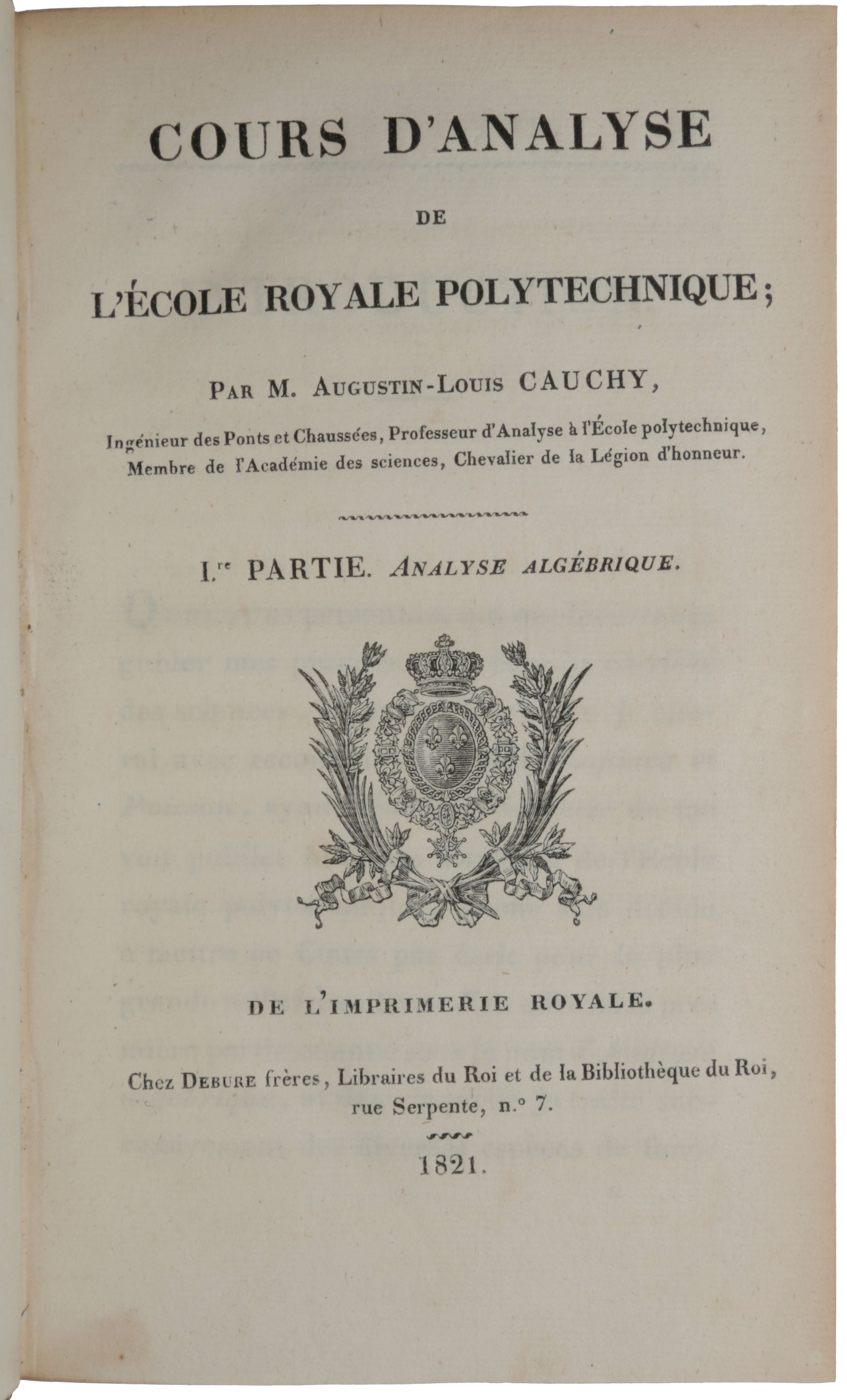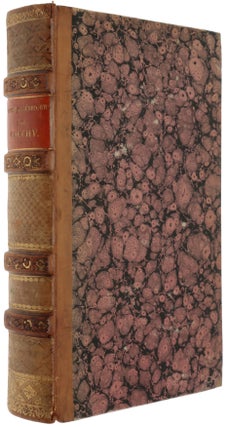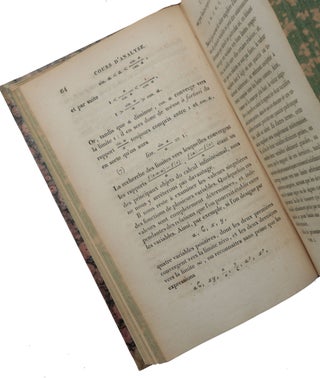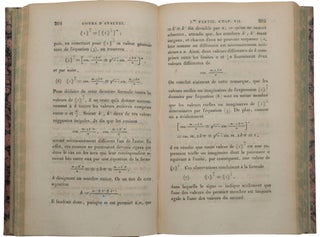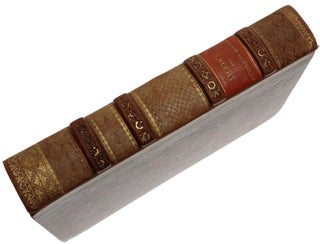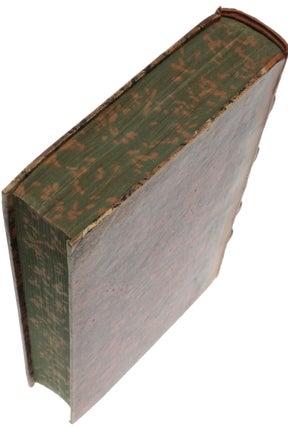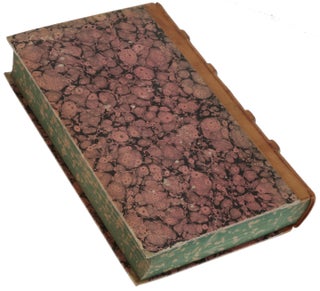Cours d’analyse de l’École Polytechnique; I.re Partie. Analyse algébrique.
Paris: De l’imprimerie Royale, chez Debure frères, 1821. First edition, an exceptionally fine copy, of this classic in the history of mathematics, which gives the first rigorous definitions of the notions of limit, continuity and convergence of infinite series, as well as the first comprehensive theory of functions of a complex variable. “In 1821, Augustin-Louis Cauchy (1787-1857) published a textbook, the Cours d’analyse, to accompany his course in analysis at the École Polytechnique. It is one of the most influential mathematics books ever written. Not only did Cauchy provide a workable definition of limits and a means to make them the basis of a rigorous theory of calculus, but he also revitalized the idea that all mathematics could be set on such rigorous foundations. Today the quality of a work of mathematics is judged in part on the quality of its rigor; this standard is largely due to the transformation brought about by Cauchy and the Cours d’analyse” (Bradley & Sandifer, p. vii). “Cauchy rivaled Euler in mathematical productivity, contributing some 800 books and articles on almost all branches of the subject. Among his greatest contributions are the rigorous methods which he introduced into the calculus in his three great treatises: the Cours d’analyse de l’École Polytechnique (1821), Résumé des leçons sur le calcul infinitesimal (1823), and Leçons sur le calcul differential (1829). Through these works Cauchy did more than anyone else to impress upon the subject the character which it bears at the present time” (Boyer, p. 271). The original development of the calculus by Leibniz and Newton had relied on intuitive geometric arguments. Although the majority of scientists and mathematicians accepted the truth of the calculus because of its impressive success in describing and predicting the workings of the natural world, especially in astronomy and mechanics, some, notably Bishop George Berkeley and Michel Rolle, were skeptical about the soundness of its foundations. Their criticisms were addressed by, among others, Colin Maclaurin and Jean le Rond d’Alembert. The next major development came in 1797, when Joseph-Louis Lagrange published his Théorie des fonctions analytiques, based on his lectures at the École Polytechnique. Lagrange used power series expansions to define derivatives, but his approach left open the question as to whether all functions could be expressed as power series. In 1815, just two years after Lagrange died, Cauchy joined the faculty at the École Polytechnique as professor of analysis and started to teach the same course that Lagrange had taught. He inherited Lagrange’s commitment to establish proper foundations for the calculus, but he followed Maclaurin and d’Alembert rather than Lagrange and sought those foundations in the formality of limits. A few years later he published his lecture notes as the present work. The year after its publication, the École Polytechnique changed the curriculum to reduce its emphasis on foundations. This probably explains why there was only one edition of the work – it became obsolete for the purpose for which it had been intended. As its title suggests, Cauchy intended to write a second part; this appeared two years later as the Résumé des leçons. The Cours begins with a short introduction in which Cauchy thanks his teachers, Ampère, Laplace and Poisson, and states his reason for writing the volume: “As for the methods, I have sought to give the rigour which one demands from geometry, so that one need never rely on arguments from the generality of algebra.” This is followed by 16 pages of ‘Preliminaries,’ in which Cauchy carefully defines his terms, distinguishing between number (which had to be positive and real) and quantity (which could be positive, negative, or zero, real or imaginary, finite, infinite or infinitesimal). In Chapters I-V Cauchy gives his new approach to limits and continuous functions, and develops their basic properties. In giving his definition of limit, he divorced the idea from any dependence on geometric intuition: “ “When the successive values attributed to a variable approach indefinitely a fixed value so as to end by differing from it by as little as one wishes, the last is called the limit of all the others.” This is the most clear-cut definition of the concept which had been given up to that time … Upon the basis of this arithmetical definition of limit, Cauchy then proceeded to define that elusive term, infinitesimal … “One says that a variable quantity becomes infinitely small when its numerical value decreases indefinitely in such a way as to converge to the limit zero” ” (Boyer, pp. 272-3). With this understood, Cauchy could now define continuity: “the function f(x) is continuous within given limits if between these limits an indefinitely small increment i in the variable x produces always an indefinitely small increment f(x + i) – f(x), in the function itself. The expressions infinitely small are here to be understood … in terms of the indefinitely small and limits” (ibid., p. 277). In Chapter VI Cauchy turns to the problem of the convergence of infinite sequences and series. “In the theory of convergence even more than in the theory of continuity, Cauchy broke new ground and set old results on a new, rigorous, foundation… We may thank all the eighteenth-century practitioners of the analysis of the infinite, especially Euler, d’Alembert and Lagrange, for having created a wealth of results and techniques for infinite series, especially power series… But recognizing the usefulness of the techniques, making the correct generalizations, and above all exploiting the methods to prove general theorems about series – these were Cauchy’s own achievements. His convergence tests, in particular, gave rise to an entirely new subject. He helped found the rigorous theory of power series, essential to nineteenth-century analysis. It was above all Cauchy’s work on infinite series that so inspired the young Abel and provided the first great contrast between Cauchy’s new rigor and the older analysis” (Grabiner, p. 109). Abel called the Cours “an excellent work which should be read by every analyst who loves mathematical rigour.” In Chapters VII-X, Cauchy turns to complex variables, what he calls imaginary quantities. “The first comprehensive theory of complex numbers is found in Cauchy’s Cours d’analyse. There he justified the algebraic and limit operations on complex numbers, considered absolute values, and defined continuity of complex functions” (DSB III: 137). Chapter X gives Cauchy’s proof of the fundamental theorem of algebra, that a polynomial of degree n has n real or complex roots. Chapters XI and XII are each short topics, partial fraction decomposition of rational expressions and recurrent series, respectively. The work concludes with what Cauchy describes in the Introduction as “several notes placed at the end of the volume [where] I have presented the derivations which may be useful both to professors and students at the Royal Colleges, as well as those who wish to make a special study of analysis” (these ‘notes’ occupy 174 pages of text). The Cours was published by the publishing family of de Bure (‘Booksellers of the King’), into which Cauchy had conveniently married in 1818. C. B. Boyer, The History of the Calculus, 1949, Ch. VII; R. E. Bradley & C. E. Sandifer, Cauchy’s Cours d’analyse. An annotated translation, 2009; J. V. Grabiner, The origins of Cauchy’s rigorous calculus, 1981; I. Grattan-Guinness, Convolutions in French mathematics, 1800-1840 (1990), Ch. 11; I. Grattan-Guinness (ed.), Landmark writings in western mathematics 1640-1940, 2005, Ch. 25. En français dans le texte 231 (‘C’est dans ses cours d’analyse de l’École Polytechnique, publiés en 1821, qu’il émet pour le première fois ses considérations sur les fonctions imaginaires … Les conséquences qui vont être dégagées des recherches de Cauchy sur les fonctions de variables complexes sont énormes, tant pour la mécanique que pour l’astronomie. Elles sont la base de toutes les methods pour l’exposition du calcul infinitésimal’).
8vo (203 x 127mm), pp. [iv], xiv, [2], 576. Contemporary half-calf and marbled boards with vellum tips, spine decorated in gilt and blind with red lettering-piece, green marbled edges. A fine and very attractive copy.
Item #5345
Price: $9,500.00

